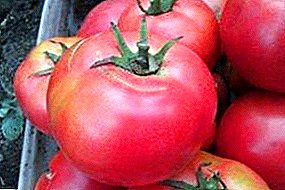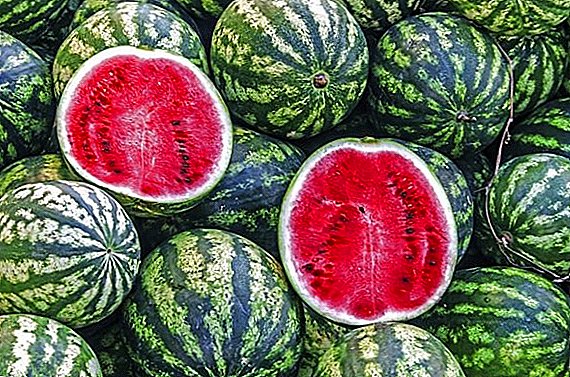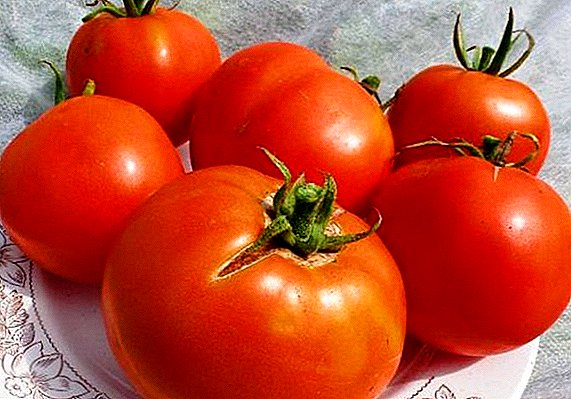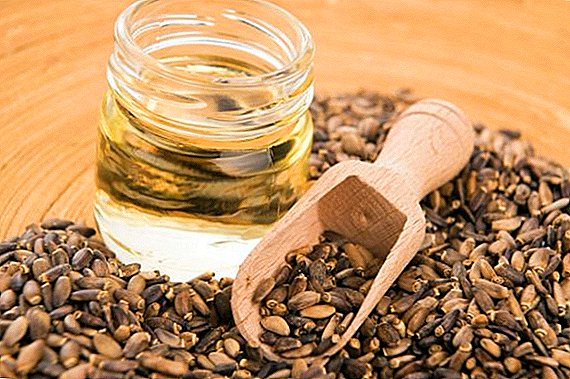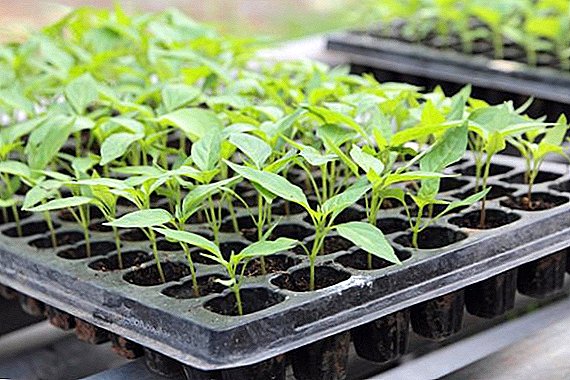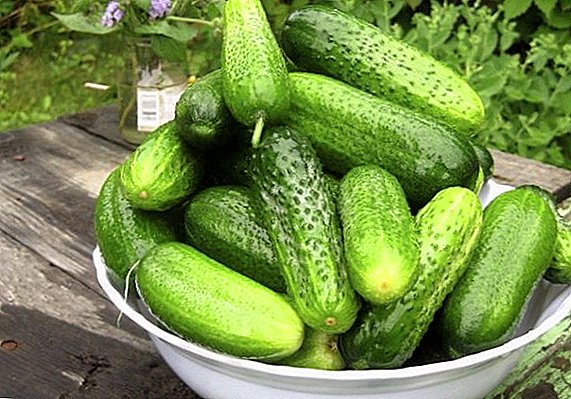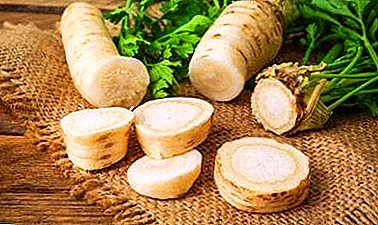
Garden parsley is a spicy plant, which gardeners have long appreciated for their unpretentiousness and beneficial properties. The content of vitamin C parsley ahead of lemons, and vitamin A more than in carrots.
The article tells about the care and cultivation of vegetables from seeds on the windowsill, in the open field or greenhouse, and also give descriptions of the varieties: Sugar, Yield, Final and others. In addition, you will learn how to harvest and preserve the crop, and which diseases and pests can interfere with the cultivation of root parsley.
Differences of cultivation from leaf type
Root parsley gives the harvest only for the second yearIn the first season, they eat fragrant greens. In order not to be disappointed in the result, choose the type of plant that is most suitable for the selected application.
How to choose a grade?
Late varieties with large long roots are suitable for long storage, and early parsley with a short short root is better for drying. Characteristics of varieties:
| Grade name | Terms of ripening | Features of the root | Application |
| Sugar | Early 95-100 days |
| Salads and canning. |
| Fruitful | Mid-season 130 days |
|
|
| Berlin | Late 150 days |
|
|
| Maroon | Late for 135 days |
|
|
| The final | Mid-season 130 days |
|
|
| Alba | Mid-season 120 days |
|
|
 Parsley variety Sugar is widely spread and won the special love of summer residents due to its features. His properties:
Parsley variety Sugar is widely spread and won the special love of summer residents due to its features. His properties:
- unpretentiousness;
- early maturity;
- resistance to low temperatures;
- tender, juicy root pulp;
- does not crack;
- greens with high taste;
- the possibility of growing in the garden, on the windowsill of the house.
The variety was bred in 1950, and in its long history has gained a lot of fans. Among the shortcomings, only the impossibility of long-term storage of the root crop is distinguished, but the benefits are much greater.
Seed cost
Buy planting material easily in any store or online trading companies that provide fast delivery. The price of one sachet with seeds weighing 2-3 g varies from 10 to 15 rubles.. This packaging allows you to purchase 1000-1500 seeds in one package.
Growing up
Sugar root parsley does not require special skills in order to get excellent results, so you do not need to apply special agricultural techniques. Observance of several conditions will allow getting greens from early spring to autumn in the first summer, juicy spicy root vegetables in the second season.
Landing
When choosing a site, pay attention to how protected the place is from winds through. Sunshine should be abundant, but light shade does not hurt. Parsley is less sick and grows better in areas after cucumbers, potatoes, tomatoes.
- Seeds are pre-soaked (from 30 minutes to 2-3 days), disinfected with a weak solution of manganese.
- Sown in the heated land in the prepared grooves to a depth of 1-2 cm.
- The distance between the rows is about 20 cm, between the plants - about 3 cm, the surface of the soil is slightly tamped and watered.
Vintage on the windowsill
At home, parsley is mainly planted in order to collect fresh greens all year round - a source of vitamins and trace elements. Growing boxes pick up bulkbecause a thin layer of soil will not allow to get a harvest. The bottom of the containers covered with a layer of drainage.
In order to achieve a friendly and quick seedlings from seeds, they are soaked for 2-3 days, periodically changing the water. The fluid temperature is maintained within + 38 ° C. Planted closer than in the garden, the distance between the rows of 10 cm, watered with settled water at room temperature.
Adequate sunshine is one of the basic conditions for good parsley growth. Therefore, boxes of plants are placed on the windowsills of the south, south-east windows. In case of insufficient lighting, a special phyto-lapma with pink light will help.
How to grow outdoors?
 In warm climates, parsley is planted with dry seeds in winter. (October November). This gives early friendly shoots - a few weeks earlier than spring crops. The snow cover keeps the soil from freezing in winter, in snowless winters the beds are covered with straw, sawdust, and mulch - a layer of 2-3 cm.
In warm climates, parsley is planted with dry seeds in winter. (October November). This gives early friendly shoots - a few weeks earlier than spring crops. The snow cover keeps the soil from freezing in winter, in snowless winters the beds are covered with straw, sawdust, and mulch - a layer of 2-3 cm.
Spring planting is carried out early, mid-April is a good period, Sugar Parsley is not afraid of low temperatures and will easily tolerate return frosts. Root parsley is not grown by seedlings - the risk of picking damage to the roots is too great.
For quick germination apply germination and hardening. For this:
- The soaked seeds are laid out on a damp cloth and left in a warm place until the shoots hatch.
- Then they are placed on the lower shelf of the freezer, after a week the seeds are ready for planting, friendly shoots will not die from a decrease in temperature.
In the greenhouse
It is possible to plant Sugar Parsley in the greenhouse already in early March.
- For rapid germination, seeds are soaked for 3-5 days at room temperature in wet gauze.
- Hacked seeds are kept for at least 10 days in wet tissue, but already at low temperature conditions - no higher than + 2 ° C.
This method will ensure the rapid emergence of shoots and a friendly early harvest - up to 1, 5 kg per 1 sq. M.
Airing greenhouses - a mandatory measure.
Under the film
Polyethylene is used to create a microclimate in the garden in areas with a cold climate and spring frosts. The beds planted in the usual way are covered with a film so that the temperature under it is at least + 20 ° C, which accelerates the emergence of shoots, even if cold weather is established. Covering material is removed with the appearance of germs.
Care
If the methods of planting are different, then the care is the same for any option and includes timely watering, fertilizing and other measures.
Thinning
The first time the procedure is carried out when real leaves appear in young plants.:
- Remove sprouts, leaving at least 3 cm free space between them.
- Take out the weak, damaged copies.
The second thinning will finally prepare parsley for further full growth. It is carried out with the appearance of 5-6 true leaves, achieve a distance between plants of 5-7 cm.
Watering
Parsley root - moisture-loving culture, so you should not allow the overdrying of the topsoil. Excessive accumulation of moisture is also undesirable, so they water the plants as needed. The best time for this is the morning or evening hours, the depth of the strait is at least 15 cm deep. Water must be defended in large tanks., pre-pouring it in order to warm the sun.
Loosening and mulching
 The upper layer of soil is necessarily loosened after heavy rains to a depth of 5-6 cm, the next day after watering. Hard crust is broken between the rows, without affecting the perimeter zone. Dry irrigation - loosening the land is regularly carried out in a greenhouse and when growing a house culture on a windowsill - this will ensure the flow of oxygen to the roots and will prevent the appearance of rot.
The upper layer of soil is necessarily loosened after heavy rains to a depth of 5-6 cm, the next day after watering. Hard crust is broken between the rows, without affecting the perimeter zone. Dry irrigation - loosening the land is regularly carried out in a greenhouse and when growing a house culture on a windowsill - this will ensure the flow of oxygen to the roots and will prevent the appearance of rot.
After sowing seeds, the beds are mulched with a thin layer of peat or rotted manure. Be sure to remove the weeds, especially in the first weeks after germination. Hilling of parsley is performed when the above-ground portion exceeds 10-12 cm..
Fertilizer
Parsley is fed after each thinning, using universal fertilizers in which there is nitrogen, potassium, phosphorus. 30 g of the complex preparation is dissolved in 10 l of water and watering the beds.
Errors
- Winter Thaw - reason to avoid Sugar Parsley winter planting. The sprouts that appear due to a sudden increase in temperature will freeze when normal winter weather returns, and all the work will be lost.
- Summer heat - a mandatory reason for abundant irrigation of culture. During this period of accumulation of essential oils, it is important to give the plants enough moisture so that the roots do not grind and become coarse and non-aromatic.
Collection and storage
For picking roots choose a sunny dry day.. The procedure is simple and does not require special devices:
- Greens cut off, leaving a small stump above the ground.
- Each root crop is carefully pulled out of the ground, shaking off.
- Leave to dry in the garden.
- Collected after a few hours in boxes or bags.
Diseases and pests
 Parsley pests are few. Major:
Parsley pests are few. Major:
- celery fly - destroyed by processing wood ash;
- carrot leaf - afraid of tobacco dust;
- umbrella moth - dies from treatment with a strong soap or pepper solution.
Diseases occur due to non-compliance with growing technologies. Black rot, powdery mildew attacks due to high humidity. From rust, septoriosa will save disinfection of the soil and seeds Bordeaux liquid.
Root crops will not be branched, if you use only rotten organic fertilizer for the land. For early greenery in the spring leaves in the winter a few roots in the ground, sprinkled them with peat. The simplicity of Sugar Parsley will allow even an inexperienced gardener to grow a rich harvest. Compliance with the basic rules - this is the key to a good result.


